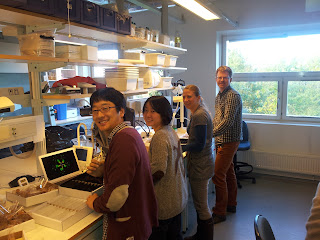Posted by Erik Svensson
In the latest issue of Journal of Evolutionary Biology there is a so-called "Target Review" by a large group of evolutionary biologists entitled: "Hybridization and speciation". This review, as well as the comments on it, are published "Open Acccess", meaning that anyone can read and download them, even if you are not in a university library. One of the co-authors of this multi-authored paper is by the way Fabrice Eroukhmanoff, former PhD-student in Lund and past member of the EXEB lab, and currently postdoc in Oslo (Norway). Below is the Abstract:
The Target Review is, as usual for these types of invited reviews, followed by a number of comments, some of them critical, by several evolutionary biologists, including myself. My comment can be found here and is entitled: "Beyond hybridization: diversity of interactions with heterospecifics, direct fitness consequences and the effects on mate preferences". There are also contributions by Nick Barton, Servedio, Hermisson and Dorn, Seehausen, Björklund and Shaw and Mendelson, to mention only a few comments of what seems to be an interesting discussion around a controversial topic, namely the role of hybridization in speciation. Enjoy!
In the latest issue of Journal of Evolutionary Biology there is a so-called "Target Review" by a large group of evolutionary biologists entitled: "Hybridization and speciation". This review, as well as the comments on it, are published "Open Acccess", meaning that anyone can read and download them, even if you are not in a university library. One of the co-authors of this multi-authored paper is by the way Fabrice Eroukhmanoff, former PhD-student in Lund and past member of the EXEB lab, and currently postdoc in Oslo (Norway). Below is the Abstract:
Abstract
The Target Review is, as usual for these types of invited reviews, followed by a number of comments, some of them critical, by several evolutionary biologists, including myself. My comment can be found here and is entitled: "Beyond hybridization: diversity of interactions with heterospecifics, direct fitness consequences and the effects on mate preferences". There are also contributions by Nick Barton, Servedio, Hermisson and Dorn, Seehausen, Björklund and Shaw and Mendelson, to mention only a few comments of what seems to be an interesting discussion around a controversial topic, namely the role of hybridization in speciation. Enjoy!










